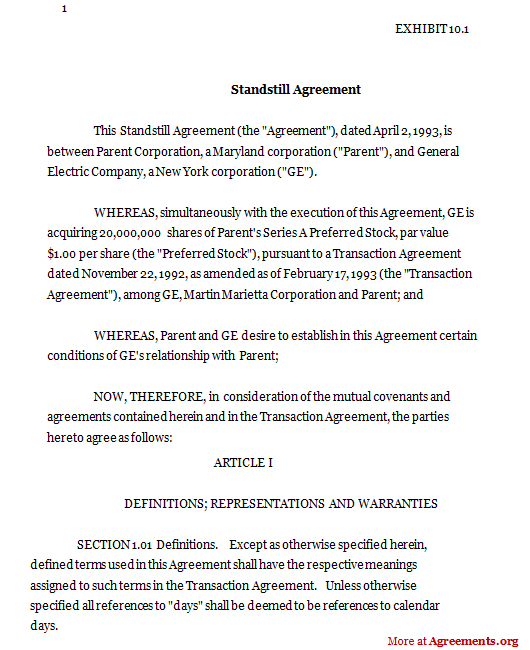What Is a Standstill Agreement?
Most standstill agreements are used to delay action for a set period of time due to various reasons. It is also used to prevent hostile takeovers. It can also be used to arrive at an agreement between the two parties to not to deal with a third party for a pre-decided period of time. And most importantly, it has often been used to extend the statutory limitation period.
Types of Standstill Agreement
There are many types of standstill contracts. Some of them are an agreement to/during:
- Extend a contractual period of time.
- Extend the statutory period according to the statute of limitations.
- Delay an action that is scheduled to happen for a certain period of time.
- A takeover situation, which can prevent a hostile takeover by restricting a shareholder from buying more shares in the company.
- The formal restructuring of a company’s debts where creditors agree not to enforce their right of collecting debts from the company for a certain period of time.
- Not associated with a third party for a set period of time.
Who Takes the Agreement?
The parties to a standstill agreement are the person or the company who wants to cause delayed action and the person or company who will delay their action as a consequence.
The agreement is taken by those who want to preserve the things as they are.
Purpose of a Standstill Agreement
There are many purposes of a standstill agreement:
- It aids in maintaining the status quo.
- It creates a window of time to restructure the liabilities of a company.
- It prevents a hostile takeover of a company by restricting shareholders from buying more shares in the company.
- It contains a standstill provision to determine how a bidder in a company can vote, sell, or buy his/her stock, and more.
- It is a legally binding agreement that protects the interests of both parties.
- A standstill operation allows extending the period of limitations or a contractual timeline.
Key Terms of the Standstill Agreement
One of the most important terms of a standstill contract is the ‘extension’ of a time period and not just its ‘suspension.’ This applies especially in the case of agreements drafted for extending the limitation period.
A standstill agreement must include:
- The personal details of the parties and the nature of their business.
- The date of commencement.
- The time period.
- The rights and obligations of parties.
- A clause that mentions what happens at the end of the standstill contract.
- A clause to prevent the delegation and assignment of any rights of the parties, without prior written consent.
- The details of the mechanism to be used to handle notices.
Drafting a Standstill Agreement
As there isn’t much time before the limitation period expires or when the deadline for a certain action to be carried out is near, many standstill contracts are not drafted well. A poorly drafted standstill agreement is a huge loss for the parties to the contract as they may not be able to enforce it as well as they would have with a well-drafted agreement.
The agreement is generally divided into parts of:
- Details of the parties
- Standstill obligation
- Standstill period
- Assignment
- Notices
- Governing law
- Dispute Resolution
- Clauses
These following guidelines can be kept in mind while drafting such agreements:
- The standstill period must be an operating part of the contract and must not be stated in recital.
- Ensure that sufficient period of standstill has been provisioned for you or your client.
- Clearly state that the parties agree to start proceeding on a certain date in the future, instead of mentioning that the parties will not issue proceedings until the end of the standstill agreement.
- As the agreement is generally drafted in haste, refer to a sample template to ensure that the important clauses of the agreement are not missed.
- The clauses of ‘indemnity’, ‘severability’, ‘force majeure’ and ‘entire agreement’ must be included in the agreement.
Negotiation Strategy
In the case of the standstill agreement, negotiation strategies can prove helpful even after the agreement is signed – to make the best use of the extra window of time and take decisions in the best interest of the company or an individual.
Benefits and Drawbacks of a Standstill Agreement
Benefits:
- It awards more time for a company to prepare for something or do something.
- It prevents a hostile takeover.
- It extends the period of limitation.
- It facilitates the performance of a contract that has run out of time.
- It helps in maintaining the status quo.
- It serves as a good record in case disputes arise in the future.
- It is proof.
Drawbacks:
- Both parties may not agree for a standstill.
- It can be time-consuming to agree on all terms for the parties.
- It involves expensive legal fees.
- Parties may misinterpret the terms of the agreement, giving rise to court disputes.
- It may be used with mala fide intention.
What Happens in Case of Violation?
When a standstill agreement is violated, it is known as a ‘breach of the standstill agreement,’ and a party can sue in court or opt for any other alternative dispute resolution procedures as agreed in the contract.
In the case of standstill agreements, the drafting is important, which is why you must refer to an online template or hire an attorney. A standstill contract provides protection with these agreements are time-extenders and those that help in keeping things ‘as is’ for a decided period of time.
Sample for Standstill Agreement
A sample of the agreement can be downloaded from below.
Standstill Agreement
Download this USA Attorney made Original Agreement for only $9.99
By clicking the button below, I agree with the Terms & Conditions.
